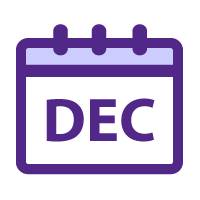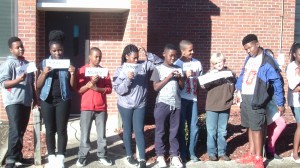
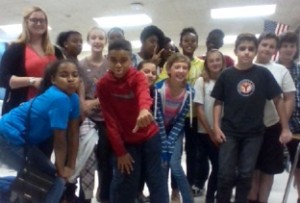
-
Caitlyn Olsen (bottom photo, top left)
Seventh-grade language arts teacher, Bates Middle School, Sumter, S.C.
- Caitlyn emailed recently to update us on her teaching career. Besides basic challenges new teachers face, she also was dealing with the results of a hurricane that closed her school for a week and destroyed many of her students’ school supplies. While she says it hasn’t been easy, she is enjoying it–even the difficult parts.
- “I love my job. I love my school. Every day I look forward to going to work. Even if I don’t feel well or have personal problems, it doesn’t matter. Teaching my kids, being with them, seeing light bulbs light up, or even their goofy comments; they brighten every minute of my day…It’s amazing that, because of the struggles, it has reaffirmed my belief that teaching is the career for me.”
- She stressed the importance of parent communication.
- “Yes, there is the recording of behavioral issues. Don’t get me wrong, that’s great, but we also need the reminder that parents need to hear when their students are doing well. Or when they did something good. Not long ago I called a couple of parents to compliment their student for sharing highlighters with other students. Furthermore, it is policy to contact low-scoring students at my school. Even if it isn’t a policy, it should be done. At any level of education, our job is to assist them in their success. An open communication between parent and teacher can be so helpful in order to accomplish this.”
- Hearing of her students’ struggles with the flooding, our COE family decided to send a few supplies (with some purple items, of course!) Five large boxes have now arrived in S.C.! Special thanks to students, faculty, and Dean Debbie Mercer for helping make this happen!


Category: November 2015
#WeAreEdCats
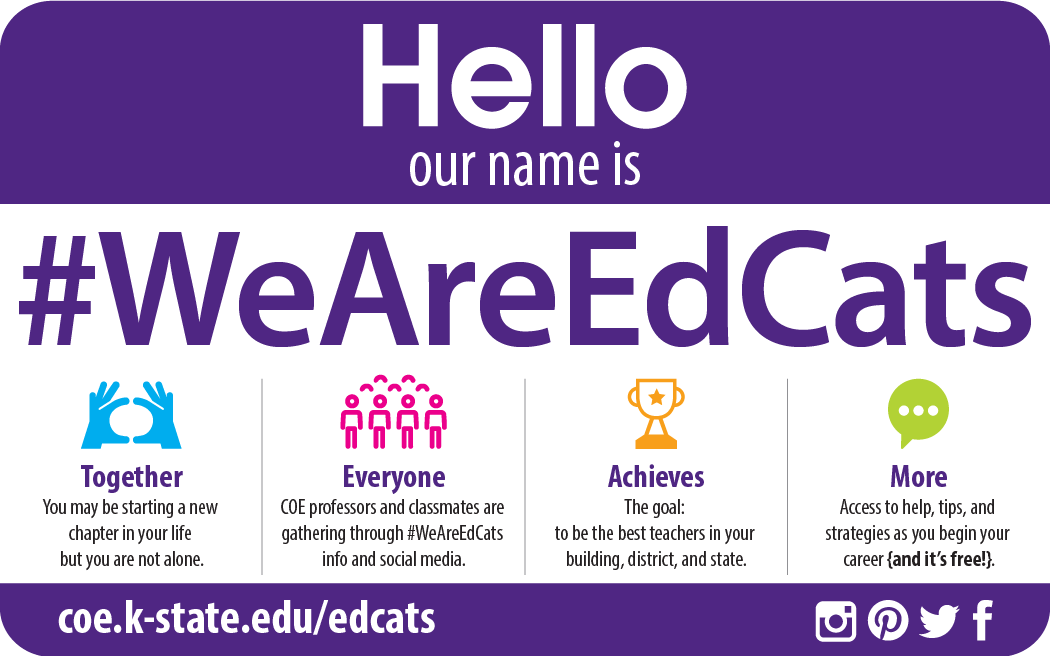 Have you checked this out yet? Join the fun today!
Have you checked this out yet? Join the fun today!
Dr. Tonnie Martinez and others are leading a new effort to help beginning teachers like you thrive as you begin your career! We spent our summer planning ways to help you, so be ready to hear lots of good things about #WeAreEdCats in the future! Check out the website at coe.k-state.edu/edcats!
Need Some Help? Faculty Suggest These Resources
Are you looking for some valuable online resources for your students? Several Curriculum and Instruction faculty suggest the following:
Dr. Brad Burenheide (Secondary Social Studies) —
- U.S. National Archives and Records Administration (NARA) (http://www.archives.gov)
- Gilder Lehrman Institute of American History (https://www.gilderlehrman.org)
- National Council for the Social Studies (NCSS) (http://www.socialstudies.org)
Dr. Tom Vontz (Elementary Social Studies) —
- Ed Teacher Tech (http://edtechteacher.org)
- Getty Images (http://www.gettyimages.com)
- Fact Monster (http://www.factmonster.com/encyclopedia.html)
Dr. Sherri Martinie (Secondary Math) —
- Illustrative Mathematics (https://www.illustrativemathematics.org)
- Mathematics Assessment Project – (http://map.mathshell.org/materials/index.php)
- NCTM Illuminations: Resources for Teaching Math (http://illuminations.nctm.org)
- Math Practice Standards resources (http://www.debbiewaggoner.com/math-practice-standards.html)
Dr. Vicki Sherbert (Secondary English/Language Arts, Speech/Theatre, Journalism) —
Dr. Phillip Payne (Music Education) —
- http://teachonline.asu.edu/objectives-builder/
- http://www.icompositions.com/
- iTunes and the App Store (these are changing every day and some are absolutely amazing!)
- Loopy and MadPad are two that are fantastic!
Dr. Tonnie Martinez (Curriculum and Instruction) —
Check out a Facebook page, “First Year Teacher Support,” she’s created at https://www.facebook.com/EdCats/
Get advice; give advice—this page is for YOU! Early-career teachers can connect to ask questions, share ideas, and support each other in navigating the first years of teaching.
Let’s Talk!
![]() Do you have a question about classroom procedures? Or a suggestion for a topic we should address in Before the Bell? Want to add your name to our mailing list? Or provide a different email for our mailing list? Or, if you’re in your first year of teaching, send us a photo of you at work in your classroom!
Do you have a question about classroom procedures? Or a suggestion for a topic we should address in Before the Bell? Want to add your name to our mailing list? Or provide a different email for our mailing list? Or, if you’re in your first year of teaching, send us a photo of you at work in your classroom!
Second-year teachers, feel free to jump in and offer suggestions to those who are following your career choice!
We’d love to hear from you, so please email us at lagoodson@k-state.edu.
Go, COE Cats!
Faculty Meetings 101
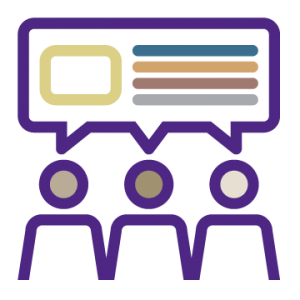 At this point, you’ve probably experienced a teaching tradition—which can’t be replicated anywhere else but within the walls of your school: The faculty meeting. You’ve probably attended two to three faculty meetings, and you’re trying to figure them out. We’ll try to address some of those burning questions you have about the ever-popular faculty meeting.
At this point, you’ve probably experienced a teaching tradition—which can’t be replicated anywhere else but within the walls of your school: The faculty meeting. You’ve probably attended two to three faculty meetings, and you’re trying to figure them out. We’ll try to address some of those burning questions you have about the ever-popular faculty meeting.
- Where do I sit? With my content teachers? My new friends? My mentor (who may or may not be my friend)? The faculty member who intimidates me the most? When you start teaching, sitting down at a faculty meeting will bring back visions of your life as a fifth-grader trying to find a spot on a school bus. Uncomfortable, humbling, awkward at best. Use the same approach you did then: Look for a smiling face—one that says “I’m not gonna steal your lunch money.” And maybe one that says, “Welcome, friend!”—only probably not quite so directly. At some meetings, you’ll find it beneficial to sit with those who are teaching similar content or age group as you; other times, by all means go with the most welcoming faces.
- How much should I say at these meetings? Should I speak my mind? There is no magic rule about this, though you’re encouraged to observe for the first few meetings. Jumping in immediately with your ideas can be a risky move, no matter how earth-shatteringly amazing you believe your ideas are. Often, as a new teacher, it’s best to quietly share your ideas with a colleague, who can help you avoid any issues that may have existed long before you joined the faculty.
- How do I deal with the colleague’s running commentary throughout the meeting? Well, smiling is always a good response—it’s neutral, not too supportive, not too negative. You’re new here, so take some time to figure out the power structure of the faculty. In time, you’ll know when it’s OK to laugh out loud and when it’s time to focus on—or at least pretend to—taking more notes about the topic at hand.
- And just what are my students doing while they’re roaming the halls before or after school? Probably…nothing good. That’s why we lock our classroom doors when we step away.
Don’t get us wrong; often faculty meetings can be beneficial—coming together in times of tragedy, celebration, and innovation. It’ll just take some time to figure out the key players and your role in these sessions.
Create a Diverse Classroom That Celebrates Everyone!
 Don’t look now, but it’s almost time to flip your calendar to 2016! That’s right – you’ve almost made it through half a year as a teacher! Congratulations!
Don’t look now, but it’s almost time to flip your calendar to 2016! That’s right – you’ve almost made it through half a year as a teacher! Congratulations!
As we move toward winter break, keep in mind that, while we may consider this the holiday season, that definition can vary from person to person. Among the celebrations are Christmas, Hanukkah, and Kwanzaa.
Remember that, while one holiday may be celebrated by the majority of your students, we all need lessons about other cultures, celebrations, and traditions. Be sure to consider the diverse group of students you have in your classroom before saturating your room with decorations or items from one culture.
Use the time to open your students’ worlds to other classmates’ beliefs. Scholastic.com suggests creating travel centers to open their world. Check out their ideas at http://www.scholastic.com/teachers/lesson-plan/winter-holidays-celebrating-diversity. Such an awareness can bring a greater respect and appreciation and make our huge world just a little bit smaller…and friendlier.
